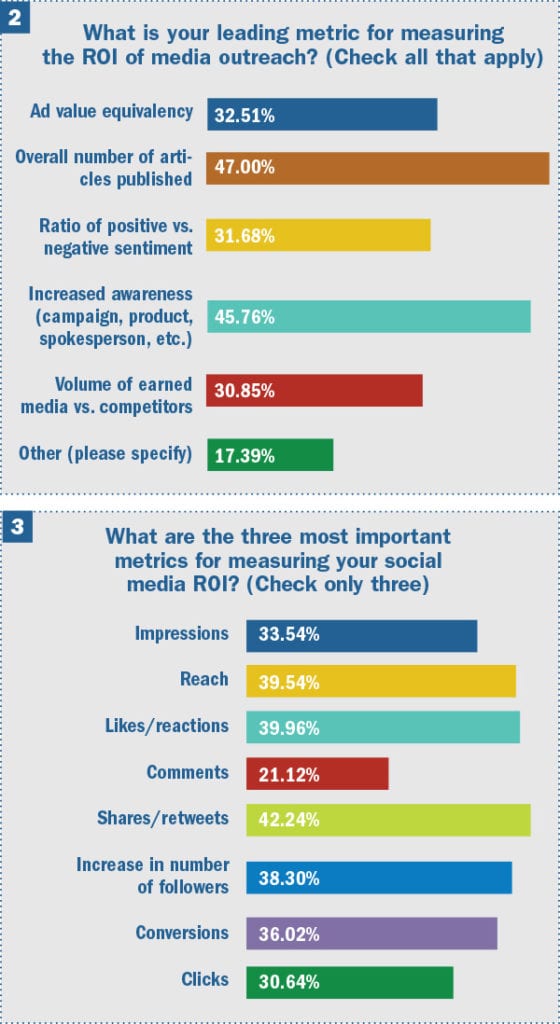
Pick your measurement maxim: ‘What gets measured, gets done,’ ‘Without measurement, you’re just guessing,’ or the popular, ‘What’s not measured cannot be improved.’
While measurement is showing real value in PR and communications, too often it’s an afterthought. Some simply avoid measurement. As IPR Measurement Commission chair Mark Weiner wrote here last month, “Measurement continues to vex our profession and stunt its potential. This is due largely to communicators who choose not to measure....”
Yet, as C-suite members continue to demand data before they make decisions, PR is hurting itself when it fails to provide it. As Weiner wrote, “In the absence of a robust calculable PR foundation, investments will continue to go to those who can and do provide the necessary data, and PR will continue to struggle.”
Measurement need not be complicated. Even conducting a basic survey with your target audience can provide important insights. For example, assume conventional wisdom says your company is great at customer service. Survey your audience. You might find that its members actually think your customer service is rather poor.

President
Intrado Digital Media
Trade shows are excellent opportunities to close a deal, right? Yet in a survey your target audience tells you signing deals is not an important part of its trade show experience. Adjustments are needed.
With the PRNEWS Measurement Boot Camp coming later this month, we and partner Intrado Digital Media surveyed communicators. Nearly 500 PR pros responded to the July survey.
As Intrado Digital Media president Ben Chodor put it, “Since data intelligence is a critical component of PR, we wanted to find out what the industry is measuring, how it’s measuring and the way success is defined.” In addition, “We were interested to hear the challenges PR pros are facing when it comes to measurement,” Chodor added.
Measurement challenges, ROI in particular, led the survey (see chart 1). Prevailing thought is that influencer marketing is one of the most difficult areas to connect with ROI. The survey, though, indicates other things are slightly more difficult. As you see, “brand awareness” (46 percent) presents the most difficulty, and “influencer marketing” (29 percent) the least, respondents said.

Trailing “brand awareness” was “brand health/reputation” (38 percent), which is another way to say trust. With so many organizations worried about experiencing PR crises, having a reserve of brand health is essential.
Chart 2 is somewhat alarming, though less surprising than chart 1. The alarm, of course, is the 33 percent response for Ad Value Equivalency (AVE), an outmoded metric. It’s not surprising that AVEs continue to enjoy strong support in the PR community, though it’s regrettable.

Also upsetting is the strong response for “overall number of articles.” While there’s nothing wrong with counting articles as a starting point, the question on this chart asks for “your leading metric for measuring the ROI of media outreach.” The articles counted could be largely negative or devoid of the company’s messaging. The next option, “ratio of positive vs. negative sentiment,” considers qualitative issues.
Increased awareness is slightly behind the leader. That’s a good KPI; recall that chart 1 showed brand awareness is a measurement pain point.
Chart 3, which asks for the top three metrics in measuring social media ROI, is more in line with accepted knowledge. “Shares/retweets” (42 percent) led the pack for ROI on social media, with “likes/reactions” (40 percent) trailing closely. That “impressions” received 34 percent is distressing, of course, as it’s typically a starting point and a metric that the C-suite considers unimportant. On the other hand, there was solid response for advanced KPIs such as “conversions” (36 percent) and “increase in the number of followers” (38 percent).
Chart 5 indicates few organizations expect influencers to result in “sales increases” or “conversions” (each at 8 percent). Instead, “social media engagement” seems the top goal (21 percent).
Chart 5 seeks to discern the primary metric for determining influencer ROI. “We don’t use influencers,” some 40 percent said. That's surprising. $15 billion will be spent on influencer marketing by 2022. This is per Business Insider Intelligence estimates, based on Mediakix data. As such, we thought more respondents would be deploying influencers.
Indeed they might be, though questions surrounding definition intrude. Do the survey respondents see micro-influencers as influencers, for example? “It would be interesting to know more about how respondents are defining influencers,” Chodor said. “While not every PR campaign involves a celebrity influencer, micro-influencers continue to gain popularity...and be featured more and more as part of communications strategies.”
Readers might recall seeing chart 6 in the September edition of PRNEWS, which shows almost 60 percent of communicators don’t pay outside sources to help with measurement. There’s nothing wrong in-house staff measuring. The issue is whether or not measurement is a high priority. For example, are in-house staffers attending to measurement regularly or does it fall through the cracks sometimes?
The responses in chart 7 indicate companies are forgoing hiring partners to help with measurement for budget reasons. Taken together, it’s “too expensive” (38 percent) and we’re “unclear about the value” (21 percent) provide a significant majority of budgetary reasons for failing to hire outside help for measurement. On the upside, 25 percent picked, “We already have an internal structure” for measuring.
The previous edition of PRNEWS also included chart 4. Measurement ailments and budget issues are the chart's highlights. A total of 44 percent said “budget” is hampering measurement and 38 percent pointing to a “lack of internal budget.”

Several other takeaways from chart 4 include communicators overwhelmed about what to measure. Too many places have collectible data, 38 percent said. There’s “too much data,”18 percent said. In addition, there’s confusion over measurement goals. There's a lack clarity in KPIs, 35 percent said. Leadership has failed to agree about what to measure, said 25 percent.

The largest measurement hurdle, respondents said, was “the need for better measurement tools” (52 percent). That could be true, of course, but it also may be a convenient way to explain away why many communicators choose to avoid measuring. Attention vendors: It also could be a cry for better tools or a plea for more training on existing ones.
CONTACT: [email protected]
